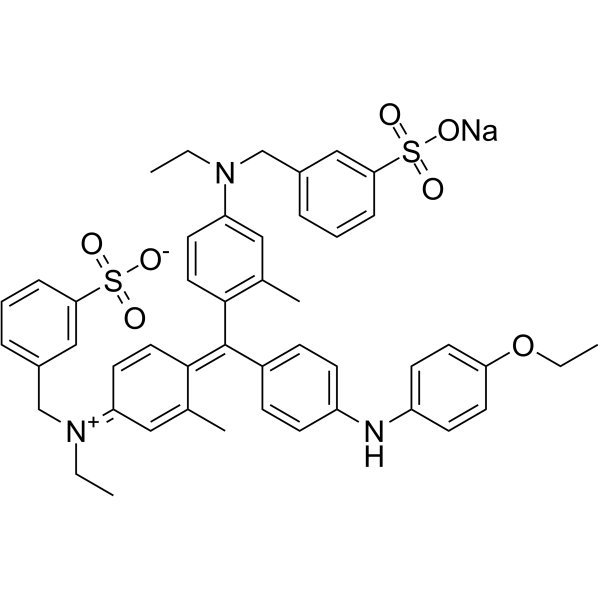Brilliant blue G-250

Brilliant blue G-250 structure
|
Common Name | Brilliant blue G-250 | ||
|---|---|---|---|---|
| CAS Number | 6104-58-1 | Molecular Weight | 854.020 | |
| Density | >1.0 g/cm3 (20ºC) | Boiling Point | N/A | |
| Molecular Formula | C47H48N3NaO7S2 | Melting Point | 100 °C | |
| MSDS | USA | Flash Point | 11 °C | |
| Symbol |



GHS02, GHS06, GHS08 |
Signal Word | Danger | |
|
Contrast recognizability during brilliant blue G - and heavier-than-water brilliant blue G-assisted chromovitrectomy: a quantitative analysis.
Acta Ophthalmol. 91(2) , e120-4, (2013) To evaluate the potential of heavier-than-water brilliant blue G (BBG-D(2) 0) to stain the internal limiting membrane (ILM) during chromovitrectomy.In a nonrandomized, prospective, clinical multicentre study, 71 consecutive chromovitrectomy interventions in 7... |
|
|
Reconfiguring the quorum-sensing regulator SdiA of Escherichia coli to control biofilm formation via indole and N-acylhomoserine lactones.
Appl. Environ. Microbiol. 75 , 1703-16, (2009) SdiA is a homolog of quorum-sensing regulators that detects N-acylhomoserine lactone (AHL) signals from other bacteria. Escherichia coli uses SdiA to reduce its biofilm formation in the presence of both AHLs and its own signal indole. Here we reconfigured Sdi... |
|
|
Lipopolysaccharide inhibits the channel activity of the P2X7 receptor.
Mediators Inflamm. 2011 , 152625, (2011) The purinergic P2X7 receptor (P2X7R) plays an important role during the immune response, participating in several events such as cytokine release, apoptosis, and necrosis. The bacterial endotoxin lipopolysaccharide (LPS) is one of the strongest stimuli of the... |
|
|
Mechanism of Coomassie Brilliant Blue G-250 binding to cetyltrimethylammonium bromide: an interference with the Bradford assay.
Anal. Biochem. 434(2) , 287-91, (2013) The Bradford protein assay is a popular method because of its rapidity, sensitivity, and relative specificity. This method is subject to some interference by nonprotein compounds. In this study, we describe the interference of cetyltrimethylammonium bromide (... |
|
|
High resolution quantitative proteomics of HeLa cells protein species using stable isotope labeling with amino acids in cell culture(SILAC), two-dimensional gel electrophoresis(2DE) and nano-liquid chromatograpohy coupled to an LTQ-OrbitrapMass spectrometer.
Mol. Cell. Proteomics 12(2) , 529-38, (2013) The proteomics field has shifted over recent years from two-dimensional gel electrophoresis (2-DE)-based approaches to SDS-PAGE or gel-free workflows because of the tremendous developments in isotopic labeling techniques, nano-liquid chromatography, and high-... |
|
|
Survival potential of wild type cellulose deficient Salmonella from the feed industry.
BMC Vet. Res. 5 , 43, (2009) Biofilm has been shown to be one way for Salmonella to persist in the feed factory environment. Matrix components, such as fimbriae and cellulose, have been suggested to play an important role in the survival of Salmonella in the environment. Multicellular be... |
|
|
In vitro secretion and activity profiles of matrix metalloproteinases, MMP-9 and MMP-2, in human term extra-placental membranes after exposure to Escherichia coli.
Reprod. Biol. Endocrinol. 9 , 13, (2011) Premature rupture of fetal membranes (PROM) complicated with intrauterine infection has been associated to alterations of the extracellular matrix (ECM) homeostasis. The aim of this work was to evaluate the integral/functional response of the amnion (AMN) and... |
|
|
Residual internal limiting membrane after epiretinal membrane peeling: results of the Pan-American Collaborative Retina Study Group.
Retina (Philadelphia, Pa.) 33(10) , 2026-31, (2013) To determine the degree of residual internal limiting membrane (ILM) after idiopathic epiretinal membrane (ERM) peeling and the usefulness of staining with brilliant blue G.A prospective, multicenter, observational study of 98 eyes undergoing pars plana vitre... |
|
|
Analysis of the Plasmodium falciparum proteasome using Blue Native PAGE and label-free quantitative mass spectrometry.
Amino Acids 43(3) , 1119-29, (2012) Detailed knowledge of the composition of protein complexes is crucial for the understanding of their structure and function; however, appropriate techniques for compositional analyses of complexes largely rely on elaborate tagging, immunoprecipitation, cross-... |
|
|
Differences in purinergic amplification of osmotic cell lysis by the pore-forming RTX toxins Bordetella pertussis CyaA and Actinobacillus pleuropneumoniae ApxIA: the role of pore size.
Infect. Immun. 81(12) , 4571-82, (2013) A large subgroup of the repeat in toxin (RTX) family of leukotoxins of Gram-negative pathogens consists of pore-forming hemolysins. These can permeabilize mammalian erythrocytes (RBCs) and provoke their colloid osmotic lysis (hemolytic activity). Recently, AT... |